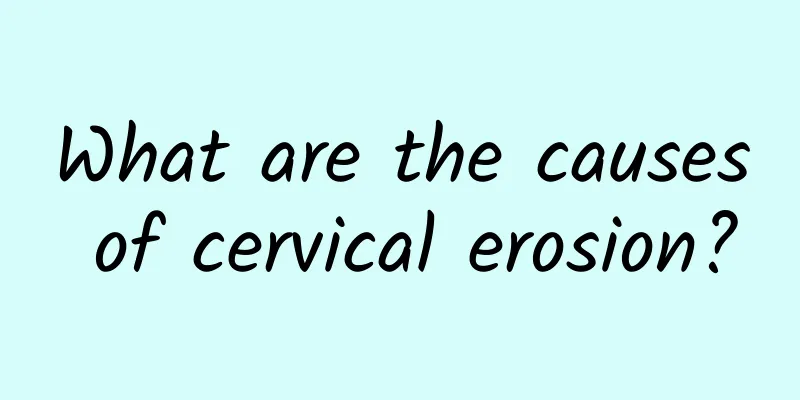What should be paid attention to when treating cervical erosion? Interpretation of common sense of treatment for female cervical erosion

|
We talk about many cases of cervical "erosion" which are not really "rotten". If it is really "eroded", how should we deal with it? Faced with a variety of high-tech "physical knives", how should we choose? Physical therapy is currently the most common and most effective method for treating cervical erosion. The principle is to use a variety of visible and invisible "physical knives" to destroy the single-layer columnar epithelium on the cervical erosion surface, causing it to fall off and allowing it to grow a stratified squamous epithelium again. Speaking of physical therapy, just by listening to the advertisements, everyone can list a series of terms: freezing, laser, Bom light, microwave, self-coagulation knife, infrared. They all sound high-tech, but it seems that many small clinics also have them, and doctors often say that it varies from person to person. How should we choose? At a health consultation, female friends spoke out their requirements. "I am afraid of pain, which method is easier?" "Gynecological problems are most afraid of recurrence, which is time-consuming and laborious. I would rather work harder this time, and the most important thing is not to relapse." "I am busy with work, which method does not require a long rest and can work as soon as possible?" "I don't have a child yet, the most important thing is not to affect future pregnancy and childbirth." Next, let's get to know the "most mainstream" knives. Laser treatment instructions Through a carbon dioxide laser, a beam of light is emitted to the eroded surface to carbonize and scab the eroded tissue. After the scab falls off, new squamous epithelium grows (about 3 weeks). Advantages Simple, fast, and effective. During the treatment, since the laser knife does not touch the cervical tissue, the depth of the burn is easy to control (it can be appropriately shallow for those who want to have children). While removing the eroded tissue, it also has the effects of anti-inflammatory, analgesic, and promoting tissue repair. Note that some patients may have a burning sensation in the vagina during treatment. 1 to 2 weeks after treatment, there will be a lot of vaginal discharge or bloody secretions. The general healing time is about 1 month. Pregnant women, patients with various vaginitis, acute pelvic inflammatory disease, patients with excessive and frequent menstruation, and patients with systemic diseases (such as severe heart disease, blood disease, liver disease, etc.) are all contraindicated from laser treatment. Cryotherapy Description Through the local freezing effect of liquid nitrogen, the rapid cooling device is used to freeze, necrotize, and fall off the eroded tissue, allowing the new squamous epithelium to re-cover the cervical vagina. Advantages Cryotherapy does not form scars, so cervical stenosis generally does not occur, which is more suitable for women with fertility requirements. In addition, freezing can cause local blood vessels to contract and stop bleeding, so there is little bleeding after treatment; at the same time, freezing can reduce the sensitivity of nerves, so it has anesthesia and analgesia, and the patient is painless during treatment. Note that there is more vaginal discharge after treatment, which lasts for 2 to 3 weeks. Peripheral blood vessels dilate during freezing, so a temporary drop in blood pressure may occur. Ultra-low temperature stimulation can also cause autonomic dysfunction, dizziness, lower abdominal distension and pain, etc. Therefore, if the patient suffers from cardiovascular disease, treatment should be cautious, but the probability of this happening is very low. Microwave treatment instructions: Place a probe on the cervical erosion area and use different wavelengths to control the depth of the burning. Continue for 3 to 5 seconds until the eroded tissue turns pale yellow and white and coagulates and denatures. Advantages: After the local tissue of the human body absorbs a certain amount of microwaves, it can dilate local blood vessels, accelerate blood circulation, enhance tissue metabolism, enhance the phagocytic function of white blood cells, promote the absorption and dissipation of pathological products, and thus promote the regeneration and repair of the body. At the same time, it also has good anti-inflammatory and bactericidal effects. Note that 3 to 5 days after treatment, a small amount of pale yellow watery secretions will be discharged, and 7 to 10 days, a small amount of bloody secretions will be discharged, which generally lasts for about two weeks. Therefore, keep the vulva clean, do not wear tight underwear, prohibit bathing and vaginal douching, avoid lifting heavy objects and riding a bicycle within a week, and follow up once a month and two months. Generally speaking, physical methods can cure cervical erosion. If the above treatment is ineffective, or the erosion surface is deep and wide, and involves the cervical canal, cervical conization or Leep knife cervical circumcision can be considered. However, since this operation can easily cause cervical stenosis and have a greater impact on fertility, it is recommended to fully communicate with the doctor. Not all real erosions need to be treated. At present, there are some differences among domestic and foreign scholars on whether cervical erosion needs to be treated. Foreign scholars believe that if there are no symptoms, no treatment is required, only cytological screening is required, and then corresponding treatment is given according to the results (for the analysis of cytological results, please see the article "Huashan Lunjian: Cervical Cancer Screening Methods" in the first half of July of this magazine). Some domestic experts believe that when "eroded", the columnar epithelium of the cervical canal is not as resistant as the normal squamous epithelium, which makes it easy for pathogens to invade and aggravate inflammation, so treatment methods should be used to destroy the columnar epithelium and let it grow back to squamous epithelium. It is generally believed that moderate and severe cervical erosion, especially granular or papillary cervical erosion, should be treated. If there are symptoms, such as bleeding during sexual intercourse, no matter which type, it should be actively treated. The classification of cervical erosion is divided into three degrees: mild, moderate and severe according to the size of the eroded surface. When the erosion area is less than 1/3 of the entire cervical area, it is mild cervical erosion; when the erosion area accounts for 1/3 to 2/3 of the cervical area, it is moderate erosion; when the erosion area accounts for more than 2/3 of the entire cervical area, it is severe erosion. Erosion types are divided into three types. Simple erosion is more common in the early stage of inflammation. The erosion surface is covered by a single layer of columnar epithelium, and the epidermis is relatively flat and smooth; if the inflammation persists, the cervical epithelium overproliferates, the erosion surface is uneven and granular, which is granular erosion; if the interstitial hyperplasia is significant, the unevenness is more obvious, and it is papillary, which is papillary erosion. These three types can exist alone or coexist alternately. Before and after physical therapy Before treatment is generally performed within 3 to 7 days after menstruation is over. Be sure to perform routine cervical cytology. Acute genital inflammation is a contraindication. The vulva, vagina and cervix must be fully disinfected. After treatment, vaginal discharge usually increases, even watery discharge. Keep the vulva clean and dry to prevent infection. Sexual intercourse, bathing and vaginal douching are prohibited before the wound is completely healed (8 weeks). After treatment, check once a month to check the wound healing. (The above content is only authorized for exclusive use by Experts Online. Please do not reprint without permission.) |
<<: Can female cervical erosion be cured? What are the best treatments for cervical erosion?
Recommend
New Taipei City inspects Yuhe Foods for storing suspicious U.S. beef
Chase, chase, chase, chase American beef with cle...
What are the secondary degenerations of uterine fibroids?
Uterine fibroids are common in daily life and are...
What is the normal level of prolactin during pregnancy?
The normal value of prolactin during pregnancy is...
Which hospital is good for treating moderate cervical erosion?
In life, nine out of ten women have cervical eros...
What are the dangers of heavy menstrual flow and blood clots?
Heavy menstrual flow with blood clots is an issue...
What are the categories of menstrual disorders?
Are there classifications for irregular menstruat...
Obesity comes from the mouth! Is the brain's appetite monster out of control? Doctor: 4 tips for weight loss management to combat obesity
Have you tried many ways to lose weight, but alwa...
What physical abnormalities can warn of adnexitis?
Women should always pay attention to their own ab...
Does Bartholin's gland infection reduce the chance of pregnancy?
Does Bartholinitis affect pregnancy? Bartholiniti...
What are the dangers of not treating uterine fibroids?
Many people must know or understand the disease o...
Transmission routes of vaginitis Prevention measures of vaginitis
Bacterial vaginosis often occurs in our daily liv...
What happened to painless abortion?
What happened to painless abortion? Painless abor...
Can I take a shower after a miscarriage? What are the precautions for taking a shower after a miscarriage?
Many people think that they cannot take a bath af...
How to treat irregular menstruation for women? Irregular menstruation can be treated in these 4 ways
Nowadays, many women suffer from irregular menstr...
What's wrong with brown blood that doesn't look like menstruation?
What's wrong with brown blood that doesn'...









